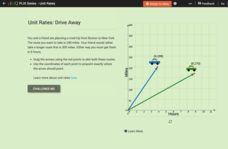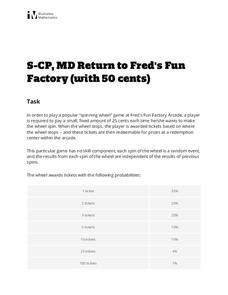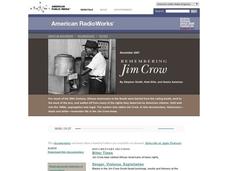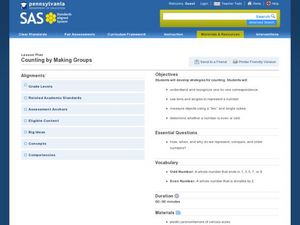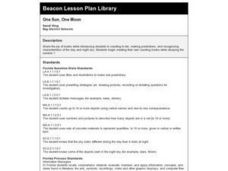CK-12 Foundation
Comparison of Unit Rates: Drive Away
Five questions make up an interactive that challenges mathematicians to compare unit rates. Word problems question scholars about two friends going on a road trip. Scholars manipulate two cars on a coordinate plane to help solve word...
Illustrative Mathematics
Return to Fred's Fun Factory (with 50 Cents)
The penny arcade gets the statistics treatment in this fun probability investigation. A non-standard game of chance is described and then the class is set loose to find missing probabilities, determine common outcomes, and evaluate...
West Contra Costa Unified School District
Introduction to Conditional Probability
Here is a turnkey lesson that walks young statisticians through the development and uses of conditional probability. From dice games to surveys, Venn diagrams to frequency tables, the class learns how a given can effect the overall...
Curated OER
Math Puzzle Picture
The key to solving this puzzle lies in the addition skills of young learners. The first step is to answer a series of decimal addition problems organized in a 4x5 grid. Then cut apart the page of puzzle pieces, each one including an...
Math Worksheets Land
Decimals to Fractions Lesson and Practice
Young mathematicians work through the concept of converting a shaded ten-frame into a mixed number and a decimal. Learners must first identify the number of wholes. Then, they find the fraction part. After writing the...
Inside Mathematics
Expressions
Strive to think outside of the quadrilateral parallelogram. Worksheet includes two problems applying prior knowledge of area and perimeter to parallelograms and trapezoids. The focus is on finding and utilizing the proper formula and...
EngageNY
Changing Scales
Pupils determine scale factors from one figure to another and the scale factor in the reverse direction. Scholars compute the percent changes between three figures.
Illustrative Mathematics
Reasoning about Multiplication and Division and Place Value, Part 1
Help your class make sense of quantities and their relationships. Given is the product of two numbers. It is up to your number crunchers to think about the quantitative relationship when the product is one-tenth or ten times the product...
Charleston School District
Identifying Series and Determining Congruence or Similarity
Learners consider a set of questions to determine a series of transformations that will move one figure to another. Once the series is determined, the pupil then determines whether the pre-image and image are either congruent...
Curated OER
Equal Differences Over Equal Intervals 1
Learners explore linear functions concretely using tables of values in a cooperative task. The concept of the values of linear functions changing by equal differences over equal intervals of one is emphasized. Learners will discover...
Mathed Up!
Angles: Parallel Lines
Viewers are presented with seven problems with parallel lines and angle relationships and must use the given information to find the measures of specific angles. To finish, they explain their process in finding the measures in the...
Curated OER
Counting by Making Groups
First graders represent, compare, and order numbers. In this counting skills lesson, 1st graders use manipulatives to demonstrate one-to-one correspondence and to represent numbers. This lesson includes a teacher script to guide the lesson.
Curated OER
Numeral Recognition, Matching, and Writing
Students engage in a lesson in which the teacher can evaluate, reinforce and reteach numeral recognition, one to one matching and the writing of numerals from 1-20. 'Anno's Counting Book' is used to kick off this lesson.
Curated OER
One Sun, One Moon
First graders read "Ten Black Dots" by Donald Crews and then create their own counting books focusing on the number 1 (one) and using yellow dots to represent the sun, moon and stars.
Curated OER
Worksheet One - Definite Integral
In this definite integral worksheet, students use substitution to simplify integrals. They find the values of the upper and lower points and interpret points found on a graph. Students solve this two-page worksheet.
Curated OER
Number Lines and Whole Numbers
Use number lines to visually represent addition and subtraction equations. First, scholars complete an addition number sentence and represent the equation on a number line. Next, they examine a number line and write the corresponding...
Curated OER
Understand a Fraction on a Number Line
Each of these fractions has an accompanying number line, segmented only by lines. Scholars match the fractions to the corresponding number line based on how many total segments (denominator) and the line circled (numerator). This...
Curated OER
Number Line Snacks: Compare Numbers to 10
Kindergarteners put Cheerios or cheddar fish on two number lines (up to 10 each) and identify which number the snack pieces indicate. They compare numbers after eating a few of each snack, and get an introduction to addition and...
Curated OER
Race to the Top
Here is a game that will help your young mathematicians practice number recognition and writing numbers. Played with a spinner or dice, individual learners or a pair will play this fun number game. They will roll the die or spin the...
Illustrative Mathematics
The Napping House
How many people and animals can cram into a single bed? Find out with this cross-curricular math and language arts lesson. Following along with a reading of the children's book The Napping House by Audrey Wood, young mathematicians...
K-5 Math Teaching Resources
Fraction Strips
Reach out to your visual and kinesthetic learners with this set of printable fraction strips. Not only is this resource a great way to develop children's fractional number sense, it's bound to capture their engagement as well.
Illustrative Mathematics
Logistic Growth Model, Abstract Version
Here learners get to flex some serious algebraic muscles through an investigation of logistic growth. The properties of the constant terms in the logistic growth formula are unraveled in a short but content-dense...
Illustrative Mathematics
Foxes and Rabbits 1
Here is where algebra learners begin to understand that a function is a rule, and for each input there is exactly one output. The commentary gets bogged down with information about the predator-prey relationship between the fox and...
Curated OER
Counting: 1-100
A simple worksheet with pictures of drums in a 100-chart format. Have your students count the drums, and identify where the drums are that correspond to numbers ending in zero and five. Enlarge on a copier to 11x17 sized paper so...


